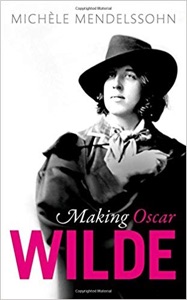Making Oscar Wilde
In 1882, Oscar Wilde was little-known Oxford graduate, a young man who had a done well in school (partly by virtue of having don't it twice), had indifferent success socially. He had received a little journalistic attention, and had far too little money. He parlayed this into an 1882-3 lecture tour of the United States.
It did not go smoothly. Wilde’s promoter, it turns out, was chiefly interested in drumming up publicity for Gilbert and Sullivan’s Patience, and for that purpose was content for Wilde to make a fool of himself. Wilde walked into a complex thicket of racial humor — the minstrel show — as well as the ancestor of drag. The doubtful racial status of the Irish in America complicated everything. Somehow, Wilde managed to preserve some dignity, avoid fatal missteps, and to return home with some profit and a considerable-enhanced reputation.
Michele Mendelssohn uncovers the story of Wilde’s lecture tour — and the fascinating competitors and parodies rival promoters launched at Wilde — from local newspaper accounts that, until recently, would have been virtually inaccessible. Of particular interest are wildly popular performers who have been lost to us, like The Only Leon — Francis Patrick Glassey — a drag ballerina who danced the lead in “Patience Wilde; or the Ten Sisters of Oscar.” Callender’s Colored Minstrels performed a Wilde parody, The Utterly Too Too’s, as a minstrel show, using the novel dramatic approach of having actual black people perform. Nor were the minstrel parodies merely irritants to Wilde: Mendelssohn observes interesting parallels between minstrel show staples and Wilde’s dramatic repartee.
